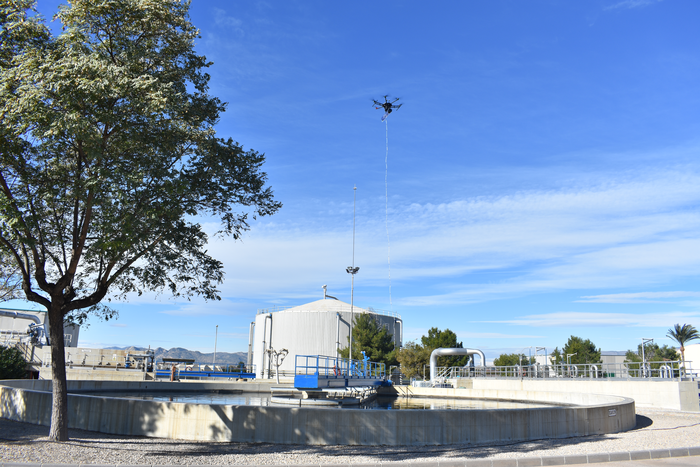Researchers from Spain have engineered a portable electronic nose (e-nose) that’s almost as sharp as a human nose at sniffing out the stink of wastewater treatment plants. Coupled with a drone, the lightweight e-nose can measure the concentration of different smells, predict odor intensity, and produce a real-time odor map of the plant for management. The method appears November 16 in the journal iScience.

Credit: Maria Deseada Esclapez
Researchers from Spain have engineered a portable electronic nose (e-nose) that’s almost as sharp as a human nose at sniffing out the stink of wastewater treatment plants. Coupled with a drone, the lightweight e-nose can measure the concentration of different smells, predict odor intensity, and produce a real-time odor map of the plant for management. The method appears November 16 in the journal iScience.
Conventionally, a wastewater plant’s odor is measured by dynamic olfactometry, where a human panel whiffs and analyzes bags of air collected from the plant. Although the method has been considered the gold standard, the process is costly, slow, and infrequent, which doesn’t allow operators to quickly respond to problems or pinpoint the root of the stench.
“I live two kilometers (1.2 miles) away from a wastewater treatment plant, and from time to time, you can’t even open the window because the smell is horrendous,” says senior author Santiago Marco of the Institute for Bioengineering of Catalonia. “We shouldn’t underestimate the impact to the quality of life for the people surrounding these facilities, and there are also physical and psychological consequences of being exposed to malodors.”
To better monitor wastewater plants’ odor emission, Marco and his team designed a portable e-nose for real-time surveillance and data visualization with the help of artificial intelligence (AI). The team collected bags of air from a plant and trained the e-nose to sniff out pungent chemicals such as hydrogen sulfide, ammonia, and sulfur dioxide, which smell like rotten eggs, urine, and burnt matches, respectively. The e-nose is also equipped with a sensor for carbon dioxide, an indicator of bacterial activity. In laboratory settings, the e-nose performed nearly as well as human noses.
The researchers then attached the 1.3-kilogram (2.9-pound) e-nose to a drone and sent it into the skies at a medium wastewater treatment plant in the south of Spain between January and June. Hovering over different facilities at the plant, the “sniffing drone” sucks in air via a ten-meter (33-foot) tube and analyzes the air in a sensor chamber.
“What’s tricky with odor measurement is that it’s a human perception, and it’s not well-defined,” says co-author Maria Deseada Esclapez of Depuración de Aguas del Mediterráneo, a sewage wastewater and sanitation service company. “We are not only trying to quantify particular or individual components of the emission, but also to predict the intensity of odors as perceived by humans.”
The results demonstrated that the e-nose on a drone was feasible for wastewater odor monitoring. When analyzing the same air samples in a field test, 10 out of 13 measurements from the e-nose aligned with the human panel’s assessments. Aided by the drone’s mobility and the AI algorithm, the team also mapped out the temporal and spatial odor concentration and, for the first time, predicted the intensity of the scent from drone measurements.
“We are extremely happy with the results, but we need more validation and to make the device more robust for a real plant operation,” Marco says. The team plans to shave off some extra weight from the e-nose and develop a standardized process for the method. They are also planning to further optimize the device against influence from temperature, humidity, and other environmental conditions that can affect the accuracy.
“The work may also have implications for other facilities like landfills, composting plants, or even large farms with cattle and pigs that are also known to produce all types of malodors,” Marco says.
“We are eager to see what impact this work would have on the industry,” adds Esclapez.
###
This work was supported by from the ATTRACT project funded by the EC, the Departament d’Universitats, Recerca i Societat de la Informació de la Generalitat de Catalunya, the Comissionat per a Universitats I Recerca del DIUE de la Generalitat de Catalunya, the European Social Fund (ESF), and the Institut de Bioenginyeria de Catalunya (IBEC)
iScience, Burgués et al.: “RHINOS: A lightweight portable electronic nose for real-time odour quantification in wastewater treatment plants” https://www.cell.com/iscience/fulltext/S2589-0042(21)01342-0
iScience (@iScience_CP) is an open-access journal from Cell Press that provides a platform for original research and interdisciplinary thinking in the life, physical, and earth sciences. The primary criterion for publication in iScience is a significant contribution to a relevant field combined with robust results and underlying methodology. Visit: http://www.cell.com/iscience. To receive Cell Press media alerts, contact [email protected].
Journal
iScience
DOI
10.1016/j.isci.2021.103371
Method of Research
Experimental study
Subject of Research
Not applicable
Article Title
RHINOS: A lightweight portable electronic nose for real-time odour quantification in wastewater treatment plants
Article Publication Date
16-Nov-2021




